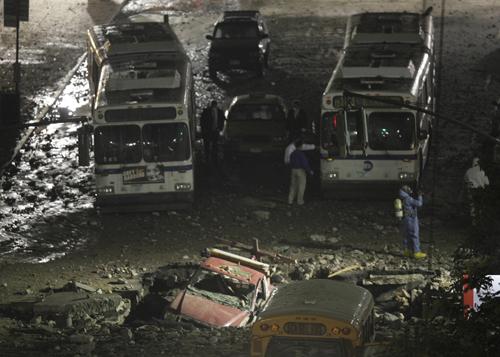NYC blast warns of aging U.S. cities

A truck lies in a hole in the street after a steam explosion in midtown Manhattan, New York, Wednesday, July 18, 2007. Seth Wenig, The Associated Press
July 20, 2007
NEW YORK – With a blast that made skyscrapers tremble, an 83-year-old steam pipe sent a powerful message that the miles of tubes, wires and iron beneath New York and other U.S. cities are getting older and could become dangerously unstable.
The steam conduit that exploded beneath a Manhattan street at the height of rush hour Wednesday, just a block from Grand Central Terminal, was laid when Calvin Coolidge was president, and was part of a system that began providing energy to city buildings in 1882.
Investigators are still trying to determine what caused the explosion, but some experts said the age of the city’s infrastructure was a possible factor. Pipes don’t last forever.
“This may be a warning sign for this very old network of pipe that we have,” said Anil Agrawal, a professor of civil engineering at the City College of New York. “We should not be looking at this incident as an isolated one.”
From Boston to Los Angeles, a number of American cities are entering a middle age of sorts, and the infrastructure propping them up is showing signs of strain.
Get The Daily Illini in your inbox!
DePaul University transportation professor Joe Schwieterman said his city of Chicago, where much of the infrastructure dates to the early part of the 20th century, is now faced with tough choices on what to fix first.
“The aging infrastructure below the streets is an enormous liability for the city,” Schwieterman said. “We know it needs modernization but the cost is staggering. We’re forced to pick our battles wisely.”
Thousands of miles of underground water and sewage pipes are nearing the end of their expected life, sometimes with a bang and a flash flood.
Electrical systems, operating with components that are decades old, have been groaning to handle record power demand.
Parts of New York were plunged into darkness for a week last summer when a series of power cables failed in Queens, and much of the Northeast was blacked out when power transmission systems failed across several states in 2003.
In New York and Boston, aging sidewalk utility panels were blamed for delivering electric shocks to pedestrians and pets in wet weather.
The American Society of Civil Engineers estimates that it will take $1.6 trillion over the next five years to get the nation’s roads, bridges, dams, water systems and airports into good condition.
But replacing old parts in a labyrinth of cables, tunnels and piping, often extending hundreds of feet down, is rarely easy.
“The fact that all of this stuff is crowded together in a very small space can also make accidents worse,” said Rae Zimmerman, director of the Institute for Civil Infrastructure Systems at New York University.
“When one thing goes, other things go. When you have a water main break, it will wash out a street and break a gas line,” she said.
Associated Press writers Adam Goldman and Karen Matthews contributed to this report






